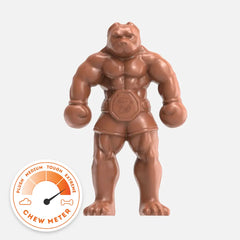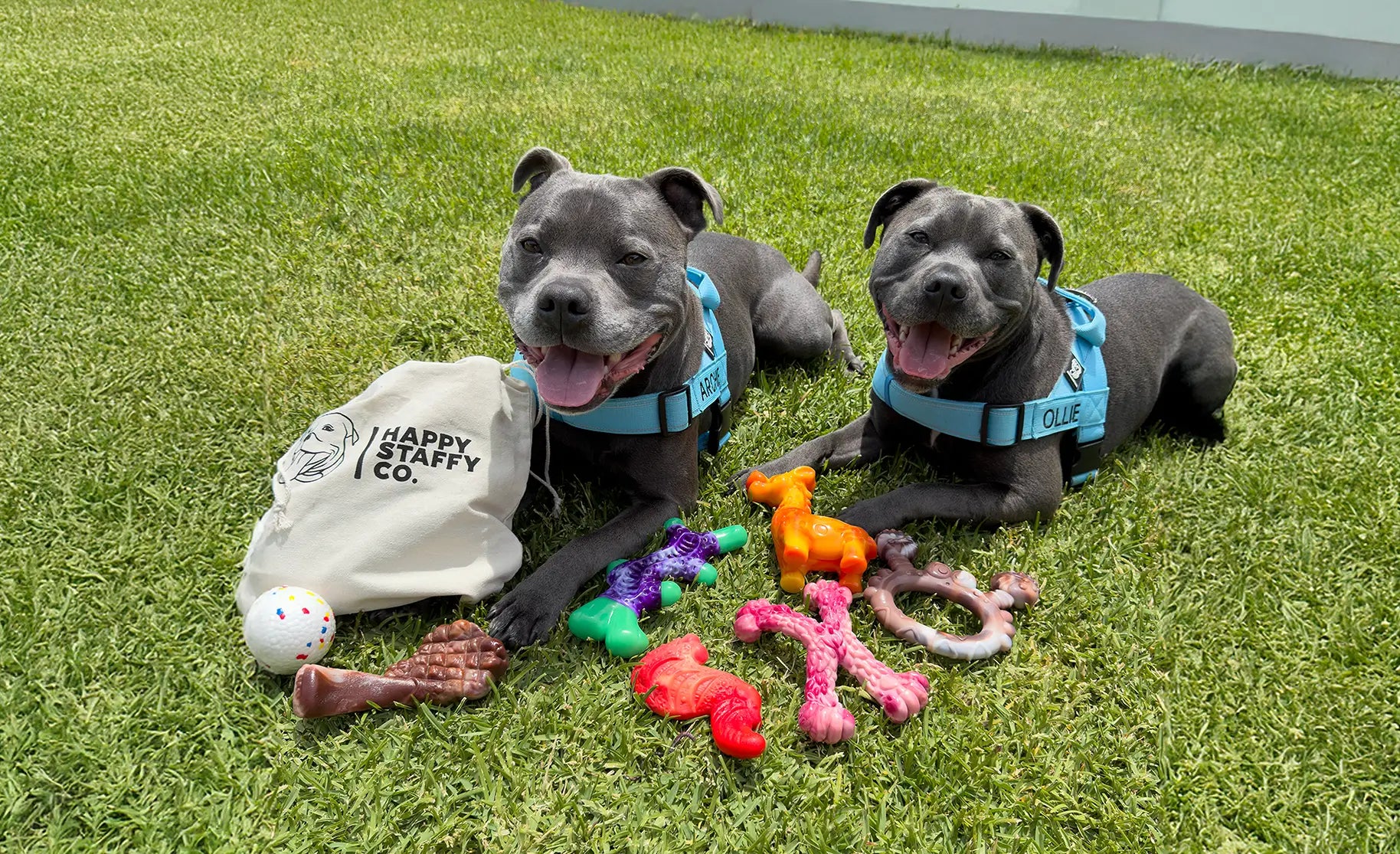The Staffordshire Bull Terrier, affectionately known as the "Staffy," has become a favorit in households across Australia. With their blend of loyalty, playful energy, and affection, Staffies are more than just pets—they are cherished members of the family.

Why Staffies Are a Beloved Family Dog
Staffies are known as “people dogs” due to their deep attachment to their families. Their affectionate and loyal nature, combined with a strong desire to please, makes them exceptional companions. They are patient and protective with children, earning them a reputation as wonderful family dogs. Their playful yet gentle nature ensures they’re always up for fun but equally enjoy quiet moments of connection.
Raising a Staffy Puppy: What You Need to Know
Bringing a Staffy puppy into your life is a special experience, filled with energy, fun, and affection. These little bundles of joy are known for their playful and curious nature, making early care and attention important for their growth. To give them the best start, establishing a daily routine is essential. Consistency in meal times, play sessions, and rest periods helps them feel secure and understand their place within the home.
Safe toys and interactive activities are perfect for keeping your Staffy puppy engaged. These activities not only satisfy their curiosity but also stimulate their developing mind, preventing boredom as they explore their new environment. This kind of enrichment supports healthy mental development and encourages positive behaviour.
Nutrition plays an important role in their growth. High-quality puppy food packed with essential nutrients helps support their rapid physical development and provides the energy they need for play and learning. Regular veterinary visits should be part of their routine as well, ensuring that their health is on track, vaccinations are current, and any concerns are addressed promptly.
Bonding is another key aspect of raising a well-adjusted Staffy. Time spent playing, gentle cuddling, and using positive reinforcement during training builds trust and nurtures their naturally loyal nature. This connection forms the basis of a lifelong relationship filled with mutual respect and affection.
Creating a nurturing space where your puppy can safely grow and learn is key. A balance of structure and affection will help them develop into a confident, well-mannered companion. With the right care and attention, your Staffy puppy will become a loving member of the family, ready to share joy and companionship for years to come.
Staffy at a Glance: Quick Breed Overview Table

Physical Characteristics of the Staffordshire Bull Terrier
With their compact, muscular build, Staffordshire Bull Terriers exude strength and agility in every step. Males generally tip the scales at 13-17 kg, while females are slightly lighter at 11-17 kg. Their medium-sized stature is all about balance—solid yet nimble, powerful yet graceful.
Common Coat Colors and Types
The short, sleek coat is both striking and easy to maintain. Whether in black, blue, fawn, red, or brindle, often with splashes of white, their coat catches the light and showcases their athletic frame. Grooming is minimal, and there’s something special about running your hand over their smooth, glossy fur after a day full of activity.
Distinctive Physical Traits
There’s no mistaking the unique look of this breed. The broad skull, defined cheek muscles, and powerful jaws are just the beginning. Their round, wide-set eyes brim with warmth and intelligence, hinting at their playful nature. Those ears—half-pricked or shaped like a rose—paired with a tail that’s constantly wagging, create an expression that’s lively and full of character.
Staffy Temperament and Personality
Confidence and intelligence are at the heart of what makes this breed so special. They’re spirited and full of life, thriving on interaction and play. But it’s not just energy; there’s a deep, loyal affection that shines through in quieter moments, reminding you that these dogs are as loving as they are lively.
When does a Staffy Stop Growing?
Staffies typically reach their full height by the time they are around 12 to 18 months old. However, while their height may stabilize during this period, their overall growth and muscle development continue beyond this. Most Staffies fully mature and fill out by the age of 2 to 3 years. This growth includes developing their signature muscular build and solid frame.
It’s important to note that factors such as genetics, diet, and exercise play significant roles in their growth rate and final size. Ensuring proper nutrition and regular exercise can help support a healthy and well-balanced growth phase. Understanding these timelines helps owners provide the right care during a Staffy’s developmental stages, fostering both physical health and overall well-being as they transition into adulthood.
Interaction with Children and Other Pets
There’s a reason they’re called “nanny dogs.” Their patience and gentle nature make them a perfect fit for families with children, offering not just companionship but unwavering loyalty and care. Proper socialization ensures they get along well with other pets, laying the groundwork for harmonious relationships and fun interactions.
Social Tendencies and Friendliness
Being surrounded by their people is where they truly come alive. This breed thrives on companionship and doesn’t do well with long periods of solitude. With their warm, welcoming nature, they greet visitors with enthusiasm, ready to make a new friend. And while they’re open and friendly, that unwavering loyalty means they’ll always be there to protect the ones they love.
Training and Socialization

Best Practices for Training a Staffy
Training is a rewarding experience with this intelligent and eager-to-please breed. Positive reinforcement is key—praise, treats, and playtime are effective motivators. Consistency and patience go a long way, turning training sessions into enjoyable bonding moments. Structured routines and clear commands help Staffies understand expectations and boost their confidence.
Importance of Early Socialization
Introducing a Staffy to various people, pets, and environments early in life is crucial. This exposure helps them grow into well-rounded and adaptable companions. Trips to the park, puppy classes, and playdates contribute to their social skills, ensuring they are comfortable and friendly in different situations.
Managing Common Behavioral Challenges
Staffies are generally well-behaved, but they can have moments of stubbornness or excitement. Addressing these behaviors early is important. Providing plenty of mental and physical stimulation helps channel their energy in a positive way, while consistent training and clear boundaries prevent undesirable habits from developing.
Exercise and Energy Levels
Daily Physical Activity Needs
High energy is part of what makes this breed so lovable. They thrive on daily exercise to keep their bodies fit and minds sharp. A mix of walks, runs, and interactive play can meet their exercise needs, keeping them happy and content.
Recommended Activities for a Happy Staffy
Activities that engage their minds and muscles are best. Fetch, tug-of-war, and agility training are perfect ways to let them burn off energy. Outdoor adventures, like hikes and trips to the beach, are also favorites that help them stay in top form.
Mental Stimulation and Enrichment Tips
Physical exercise alone isn’t enough—mental enrichment is just as important. Puzzle toys, scent games, and training new tricks keep them entertained and prevent boredom. Incorporating tasks that challenge their intelligence helps prevent destructive behaviors and nurtures a well-balanced dog.
How much exercise do Staffy need?
Staffordshire Bull Terriers generally require at least 60 to 90 minutes of exercise daily to stay healthy and happy. This time should be a mix of activities that offer both physical exertion and mental stimulation. Splitting this time into two or more sessions, such as a brisk morning walk and an interactive play session in the evening, can keep them engaged and content throughout the day. Regularly varying their activities helps keep their interest and ensures they are mentally challenged, promoting a well-rounded, balanced temperament.
Health and Common Health Issues
Potential Health Concerns in the Breed
Staffies are known for being generally healthy, but they can be prone to certain conditions. Common issues include hip dysplasia, cataracts, and skin allergies. Regular check-ups with the vet help catch these early, ensuring prompt treatment and management.
Some of the common Staffordshire Bull Terrier health problems are:
- Hip Dysplasia: This condition occurs when the hip joint doesn’t fit properly into the hip socket, leading to discomfort and mobility issues. Regular vet monitoring, a balanced diet, and appropriate exercise can help manage or prevent symptoms.
- Cataracts: Cloudiness in the lens of the eye can develop with age, affecting vision and potentially leading to blindness if untreated.
- Skin Allergies: Staffies can be prone to allergies that cause itching, redness, and discomfort. These allergies can be triggered by environmental factors, food, or contact with certain substances. Keeping their skin healthy with proper grooming and checking for signs of irritation can help manage this condition.
- Elbow Dysplasia: This joint condition affects some Staffies and can cause pain or lameness in the front legs. Early diagnosis and weight management are important for reducing the impact.
- Hereditary Cataracts: While less common, some Staffies can inherit cataracts, which require regular eye examinations and monitoring.
- Patellar Luxation: This condition involves the knee cap slipping out of place, which can cause temporary lameness or a skipping gait. Surgery may be necessary for severe cases.
Regular veterinary care, preventive measures, and a healthy lifestyle can go a long way in managing these potential health issues. Awareness of these common concerns helps you stay proactive and ensures your Staffy remains a happy and healthy companion throughout their life.
Preventive Care and Routine Check-Ups
Routine vet visits, balanced nutrition, and a consistent exercise schedule contribute to a healthy Staffy. Preventive care, including vaccinations and flea and tick prevention, supports their overall well-being and helps them lead active, fulfilling lives.
How long do staffies live for?
The average lifespan of a Staffordshire Bull Terrier ranges from 12 to 14 years. As they age, they may slow down, requiring more rest and adjusted activity levels. Ensuring they maintain a healthy weight and receive appropriate senior dog care helps them enjoy their golden years comfortably.
Diet and Nutritional Needs

Maintaining the right diet is important for a Staffy's energy levels, overall health, and longevity. This breed’s natural energy and muscular build demand a balanced and nutrient-rich diet to support their active lifestyle and growth.
Ideal Diet for a Healthy Staffy
A healthy diet for a Staffordshire Bull Terrier should be high in quality protein, which supports muscle development and maintenance. Lean proteins such as chicken, turkey, fish, and beef are excellent choices. Carbohydrates from sources like sweet potatoes, brown rice, and oats provide sustained energy, while healthy fats from fish oil or flaxseed promote brain function and help maintain a shiny, healthy coat. Including omega-3 and omega-6 fatty acids can also reduce inflammation and support joint health, particularly as they age.
Adding vegetables and fruits to their diet, such as carrots, pumpkin, blueberries, and apples (without seeds), can provide essential vitamins and antioxidants. While commercial high-quality dog food can meet most nutritional needs, some owners prefer incorporating fresh food or homemade meals to give their Staffy a varied diet. Consulting with a veterinarian or canine nutritionist can ensure any dietary changes meet their specific health requirements.
Portion Control and Feeding Schedules
Portion control is important for preventing overeating, which can lead to obesity and associated health issues like joint stress and heart problems. Feeding a Staffy two or three well-portioned meals a day helps maintain consistent energy levels and aids in digestion. Puppies require more frequent feeding, typically three to four times daily, as they are growing rapidly. Transitioning to two meals a day as they mature helps maintain a healthy weight and balanced metabolism.
Monitoring their weight regularly and adjusting portion sizes based on activity level and age is essential. Highly active Staffies may require slightly larger portions or more nutrient-dense food, while older or less active dogs benefit from controlled portions to avoid unnecessary weight gain.
Foods to Avoid
Certain foods can be dangerous or toxic to Staffies and should be avoided to keep them safe and healthy. Foods like chocolate, onions, garlic, grapes, and raisins are harmful and can lead to serious health issues. Xylitol, a common artificial sweetener found in sugar-free products, can be toxic and should be kept away from dogs entirely. Additionally, fatty and heavily processed human foods can upset their digestive system and contribute to long-term health problems.
Keeping treats to a healthy minimum and ensuring they are dog-safe is also important. Simple, dog-friendly snacks like small pieces of cooked chicken, baby carrots, or store-bought dog treats made with natural ingredients are better choices. A consistent, balanced diet combined with proper portion management ensures that your Staffy stays active, healthy, and at an optimal weight.
Grooming and Maintenance
Staffordshire Bull Terriers are relatively low-maintenance dogs when it comes to grooming. However, establishing a regular routine ensures that their coat, nails, and teeth stay in great condition and contributes to their overall health and comfort.
Coat Care and Bathing
With their short, smooth coat, grooming a Staffy is straightforward but still requires attention. Regular brushing—at least once or twice a week—helps manage shedding and keeps their coat looking sleek and healthy. A soft-bristle brush or grooming mitt works well to remove loose hair, distribute natural oils, and stimulate the skin, promoting a healthy shine. Bathing should only be done every few months or when necessary to avoid stripping their coat of essential oils. A gentle, dog-specific shampoo is best to keep their skin from drying out.
Shedding and Allergies
Though Staffies do shed, their short coat makes it more manageable than some other breeds. While they are not hypoallergenic, regular brushing and a clean environment can help reduce allergens in the home. If someone in the household is sensitive to pet dander, keeping a consistent grooming schedule and vacuuming often can help limit allergens.
Nail Trimming and Dental Hygiene
Nail trimming is essential for a Staffy’s comfort and health. Their nails should be trimmed every few weeks to prevent overgrowth, which can cause discomfort and affect their posture. Using a dog nail clipper or grinder is recommended, and it’s important to introduce nail care slowly to get them accustomed to the process.
Dental care is also crucial. Brushing your Staffy’s teeth several times a week helps prevent plaque buildup and gum disease. If brushing isn’t possible, dental chews and vet-approved dental sprays can support oral health. Regular dental check-ups during vet visits are beneficial for monitoring and addressing any potential issues early.
Seasonal Grooming Tips
Seasonal changes may require slight adjustments in grooming. In warmer months, brushing more frequently helps to keep their coat cooler and reduces the amount of loose fur around the home. During colder months, Staffies may be prone to dry skin, so it’s beneficial to use a dog-safe, moisturising conditioner during baths or add a few drops of fish oil to their food for skin health.
Living Conditions and Best Environments

Staffordshire Bull Terriers are adaptable dogs and can thrive in various living conditions, provided they receive adequate exercise, companionship, and mental stimulation. Understanding their needs in different environments ensures a comfortable and happy life for your Staffy.
Suitability for Apartment Living
Despite their high energy, Staffies can adapt well to apartment living. Regular exercise—such as daily walks and interactive play—is crucial in a smaller living space. Staffies enjoy spending time with their human companions and are generally content indoors if they’re given plenty of opportunities to burn off energy. Mental stimulation, like snuffle mats and training games, also helps keep them happy and occupied.
Ideal Home Setup
A home with a secure yard is ideal, as it gives a Staffy space to play, explore, and exercise safely. They are happiest when they can spend time with their family, both indoors and outdoors. Staffies can sometimes exhibit a strong prey drive, so ensuring the yard is fenced can prevent them from chasing after other animals. Supervised outdoor time and interactive activities, like fetch or tug-of-war, help them stay engaged and satisfy their playful nature.
Climate Considerations
Staffies thrive best in moderate climates. They are sensitive to extreme heat and cold due to their short coat. In warmer months, providing shaded areas and fresh water is essential, and limiting outdoor play during peak heat can prevent overheating. In colder weather, a dog coat or sweater helps keep them comfortable during walks or outdoor play. Monitoring their comfort in extreme weather ensures that they stay safe and happy regardless of the season.
Adoption and Responsible Ownership
Deciding to bring a Staffy into your home is a big commitment, and adopting responsibly ensures a positive experience for both you and your new companion. Whether you choose to adopt from a shelter or find a breeder, preparation and care make all the difference.
Tips for Adopting a Staffy
Adopting a Staffy from a shelter or rescue organisation can be incredibly rewarding. Many rescues have dogs of different ages and temperaments, allowing you to find a Staffy that fits well with your lifestyle. Reputable shelters often conduct temperament assessments, which can give you insight into how the dog might behave in different environments. Adoption also provides a Staffy in need with a loving home, which is especially meaningful for those rescued from challenging circumstances.
Choosing a Reputable Breeder
If you decide to get a puppy from a breeder, choosing a reputable breeder is crucial for the health and well-being of your future Staffy. Responsible breeders prioritise the health and temperament of their dogs, typically providing health clearances, vaccinations, and socialisation opportunities. Meeting the puppy’s parents and visiting the breeding environment can offer reassurance about the breeder’s practices and the conditions in which the puppies were raised.
Preparing Your Home for a New Pet
Bringing a Staffy home requires some initial setup to ensure their comfort and safety. Stock up on essentials like a comfortable bed, food and water dishes, chew toys, and grooming tools. Create a designated area in your home where they can feel secure and relax, especially during the transition period. Preparing the environment in advance helps your new Staffy settle in more easily and begin building trust in their new surroundings.





